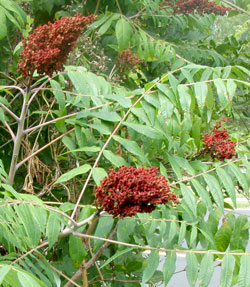Appreciating sumac
By Ken Moore
Flora Columnist
This is the time of year to observe the open flower heads of sumac slowly close in as the maturing berries come together to form the dark red seed cones that are so striking along roadsides during the fall.
Four years ago, Kathy and I left the heat of North Carolina August to visit cousins on an island off the coast of Maine. I was not looking forward to the long drive and hazards of highway travels, but as always, I calmed myself by studying the roadside vegetation along the way. Like any wild botanist, I’m happily challenged when identifying plants at 60-plus miles-per-hour. That’s why my wife prefers to drive, which is fine with me and she remains much calmer.
All the way to Maine we enjoyed patches of sumac along the roadsides. In some states, mowing crews had deliberately left the patches; sadly, in others, similar patches had been mowed or killed by herbicide application.
Our local smooth sumac, Rhus glabra, grows throughout the eastern states and overlaps with its hairy-stemmed, bigger cousin, staghorn sumac, Rhus typhina, in the Carolina mountains and northern states.
Sumac patches add dramatic landscape effect along roadsides through all the seasons: vigorous green foliage during spring and summer, red seed cone accents in late summer, brilliant orange-red foliage in the fall and red seed cone-topped bare stems during the winter months. Truly a plant for all seasons!
I am thankful for the sumac that volunteered along our Carrboro roadside. It’s now well established and I look forward every year to finding where new stems emerge. It’s easy to extract it from spots I want to keep open for other plants, but more controlling gardeners will have less patience with the exuberance of sumac.
Occasionally a sumac may produce only staminate (male) flower clusters and thus will not produce those red seed cones, but the leaves will still have the spectacular fall color.
Sumacs are a popular plant for fall color in English gardens and there are several notable cut-leaf cultivars, such as R. glabra ‘Laciniata’ and R. typhina ‘Laciniata’ for fashion-conscious gardeners. For me, the wild form is just fine!
Sumacs are valued for more than their beauty. Daniel Moerman’s Native American Ethnobotany devotes several pages to sumac’s rich medicinal heritage. A refreshing tea concocted from the crushed berries is enjoyed by many. Culinary uses are engagingly described in Euell Gibbons’ Stalking the Wild Asparagus, Tom Brown’s Field Guide: Wild Edible and Medicinal Plants and James Duke’s Handbook of Edible Weeds.
Sumacs are members of the cashew plant family, Anacardiaceae, which provides us with the popular cashews, pistachios and mangos. It’s interesting that plants in this economically important family contain poisonous components. Fortunately, most of us are not allergic to the mango and nut sumac relatives, but we have learned to keep our distance from its less appealing close kin, poison ivy, Rhus radicans, and poison oak, Rhus toxicodendron.
I was amused years ago by my cousin’s determination to eradicate the beautiful nonpoisonous sumac around his island cottage. Now, years later, I’m happy to find that, like me, he allows it freedom to roam.
Email Ken Moore at flora@carrborocitizen.com.
Find previous Ken Moore Citizen columns at The Annotated Flora





Comments are closed.